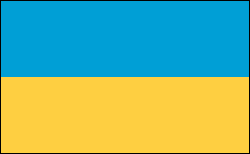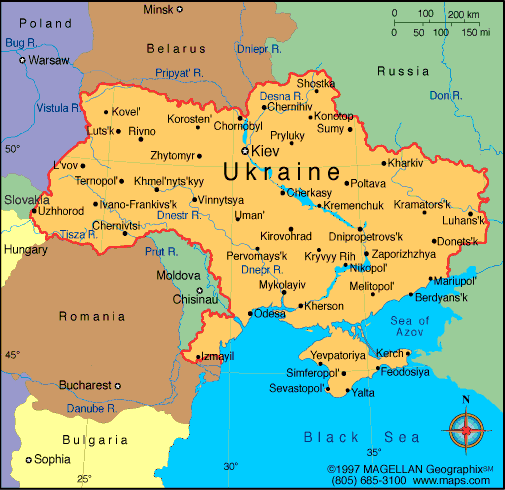UKRAINE

Geography: Located in southeast Europe, the country consists largely of fertile black soil steppes. Mountainous areas include the Carpathians in the southwest and the Crimean chain in the south. Ukraine is bordered by Belarus on the north, by Russia on the north and east, by the Black Sea on the south, by Moldova and Romania on the southwest, and by Hungary, Slovakia, and Poland on the west.
Government: Constitutional republic.
History: Ukraine was known as “Kievan Rus” (from which Russia is a derivative) up until the 16th century. In the 9th century, Kiev was the major political and cultural center in eastern Europe. Kievan Rus reached the height of its power in the 10th century and adopted Byzantine Christianity. The Mongol conquest in 1240 ended Kievan power. From the 13th to the 16th century, Kiev was under the influence of Poland and western Europe. The negotiation of the Union of Brest-Litovsk in 1596 divided the Ukrainians into Orthodox and Ukrainian Catholic faithful. In 1654, Ukraine asked the czar of Moscovy for protection against Poland, and the Treaty of Pereyasav signed that year recognized the suzerainty of Moscow. The agreement was interpreted by Moscow as an invitation to take over Kiev, and the Ukrainian state was eventually absorbed into the Russian Empire.
After the Russian Revolution, Ukraine declared its independence from Russia on Jan. 28, 1918, and several years of warfare ensued with several groups. The Red Army finally was victorious over Kiev, and in 1920 Ukraine became a Soviet republic. In 1922, Ukraine became one of the founders of the Union of Soviet Socialist Republics. In the 1930s, the Soviet government's enforcement of collectivization met with peasant resistance, which in turn prompted the confiscation of grain from Ukrainian farmers by Soviet authorities; the resulting famine took an estimated 5 million lives. Ukraine was one of the most devastated Soviet republics after World War II. (For details on World War II, see Headline History, World War II.) On April 26, 1986, the nation's nuclear power plant at Chernobyl was the site of the world's worst nuclear accident. On Oct. 29, 1991, the Ukrainian parliament voted to shut down the reactor within two years' time and asked for international assistance in dismantling it.
Government: Constitutional republic.
History: Ukraine was known as “Kievan Rus” (from which Russia is a derivative) up until the 16th century. In the 9th century, Kiev was the major political and cultural center in eastern Europe. Kievan Rus reached the height of its power in the 10th century and adopted Byzantine Christianity. The Mongol conquest in 1240 ended Kievan power. From the 13th to the 16th century, Kiev was under the influence of Poland and western Europe. The negotiation of the Union of Brest-Litovsk in 1596 divided the Ukrainians into Orthodox and Ukrainian Catholic faithful. In 1654, Ukraine asked the czar of Moscovy for protection against Poland, and the Treaty of Pereyasav signed that year recognized the suzerainty of Moscow. The agreement was interpreted by Moscow as an invitation to take over Kiev, and the Ukrainian state was eventually absorbed into the Russian Empire.
After the Russian Revolution, Ukraine declared its independence from Russia on Jan. 28, 1918, and several years of warfare ensued with several groups. The Red Army finally was victorious over Kiev, and in 1920 Ukraine became a Soviet republic. In 1922, Ukraine became one of the founders of the Union of Soviet Socialist Republics. In the 1930s, the Soviet government's enforcement of collectivization met with peasant resistance, which in turn prompted the confiscation of grain from Ukrainian farmers by Soviet authorities; the resulting famine took an estimated 5 million lives. Ukraine was one of the most devastated Soviet republics after World War II. (For details on World War II, see Headline History, World War II.) On April 26, 1986, the nation's nuclear power plant at Chernobyl was the site of the world's worst nuclear accident. On Oct. 29, 1991, the Ukrainian parliament voted to shut down the reactor within two years' time and asked for international assistance in dismantling it.

Map of Ukraine
President: Petro Poroshenko (2014)
Prime Minister: Arseniy Yatsenyuk
(2014)
Total area: 233,089 sq mi (603,700 sq km)
Population (2014 est.): 44,291,413
(growth rate: –0.6%); birth rate: 9.41/1000; infant mortality
rate: 8.1/1000; life expectancy: 69.14; density per sq mi: 191
Capital (2013 est.):
Kyiv (Kiev), 3,275,000 (metro. area),
2,847,000 (city proper)
Other large cities: Kharkiv,
1,441,622; Odessa, 1,003,705; Dnipropetrovsk, 1,001,962; Donetske, 962,024;
Monetary unit: Hryvna
National name: Ukrayina
Languages:
Ukrainian (official) 67%, Russian (regional language) 24%,
other (includes small Romanian-, Polish-, and Hungarian-speaking
minorities) 9%
Ethnicity/race:
Ukrainian 77.8%, Russian 17.3%, Belorussian
0.6%, Moldovan 0.5%, Crimean Tatar 0.5%, Bulgarian 0.4%, Hungarian
0.3%, Romanian 0.3%, Polish 0.3%, Jewish 0.2%, other 1.8% (2001)
Religions:
Orthodox (includes Ukrainian Autocephalous Orthodox (UAOC),
Ukrainian Orthodox - Kyiv Patriarchate (UOC-KP), Ukrainian Orthodox -
Moscow Patriarchate (UOC-MP), Ukrainian Greek Catholic, Roman Catholic,
Protestant, Muslim, Jewish
Note: Ukraine's population is overwhelmingly Christian; the vast majority - up to two-thirds - identify themselves as Orthodox, but many do not specify a particular branch; the UOC-KP and the UOC-MP each represent less than a quarter of the country's population, the Ukrainian Greek Catholic Church accounts for 8-10%, and the UAOC accounts for 1-2%; Muslim and Jewish adherents each compose less than 1% of the total population (2013 est.)
Note: Ukraine's population is overwhelmingly Christian; the vast majority - up to two-thirds - identify themselves as Orthodox, but many do not specify a particular branch; the UOC-KP and the UOC-MP each represent less than a quarter of the country's population, the Ukrainian Greek Catholic Church accounts for 8-10%, and the UAOC accounts for 1-2%; Muslim and Jewish adherents each compose less than 1% of the total population (2013 est.)
Literacy rate: 99.7% (2011 est.)
Economic summary: GDP/PPP (2013
est.): $333.7 billion; per capita $7,400. Real growth rate:
0.4%. Inflation: 0.7%. Unemployment: 8% officially
registered; large number of unregistered or underemployed workers;
International Labor Organization est.: 7%. Arable land: 53.85%.
Agriculture: grain, sugar beets, sunflower seeds, vegetables;
beef, milk. Labor force: 22.17 million (2013 est.); industry
18.5%, agriculture 15%, services 65.7% (2008). Industries: coal,
electric power, ferrous and nonferrous metals, machinery and
transport equipment, chemicals, food processing.
Natural resources: iron ore, coal, manganese, natural gas,
oil, salt, sulfur, graphite, titanium, magnesium, kaolin, nickel,
mercury, timber, arable land. Exports: $71.14 billion (2013
est.): ferrous and nonferrous metals, fuel and petroleum products,
chemicals, machinery and transport equipment, food products.
Imports: $87.21 billion (2013 est.): energy, machinery and
equipment, chemicals. Major trading partners: Russia,
Germany, Turkey, Egypt, China, Poland, Belarus (2012).
Communications: Telephones: main lines
in use: 12.182 million (2012); mobile cellular: 59.344 million (2012).
Radio broadcast stations: AM 134, FM 289, shortwave 4 (2007).
Radios: 45.05 million (1997). Television broadcast
stations: at least 33 (plus 21 repeater stations that relay
broadcasts from Russia) (1997). Televisions: 18.05 million
(1997). Internet Service Providers (ISPs): 2.173 million (2012).
Internet users: 7.77 million (2009).
Transportation: Railways: total: 21,619
km (2012). Highways: total: 169,694 km; paved: 166,095 km;
unpaved: 3,599 km (2012). Waterways: 1,672 km (2012).
Ports and harbors: Feodosiya (Theodosia), Illichivsk, Mariupol', Mykolayiv, Odesa, Yuzhnyy. Airports: 187
(2013).
International disputes:
1997 boundary delimitation treaty with Belarus remains unratified due
to unresolved financial claims, stalling demarcation and reducing border
security; delimitation of land boundary with Russia is complete with
preparations for demarcation underway; the dispute over the boundary
between Russia and Ukraine through the Kerch Strait and Sea of Azov is
suspended due to the occupation of Crimea by Russia; Moldova and Ukraine
operate joint customs posts to monitor transit of people and
commodities through Moldova's break-away Transnistria Region, which
remains under the auspices of an Organization for Security and
Cooperation in Europe-mandated peacekeeping mission comprised of
Moldovan, Transnistrian, Russian, and Ukrainian troops; the ICJ ruled
largely in favor of Romania in its dispute submitted in 2004 over
Ukrainian-administered Zmiyinyy/Serpilor (Snake) Island and Black Sea
maritime boundary delimitation; Romania opposes Ukraine's reopening of a
navigation canal from the Danube border through Ukraine to the Black
Sea.
-------------------- o --------------------
No comments:
Post a Comment